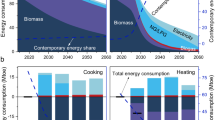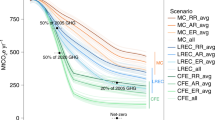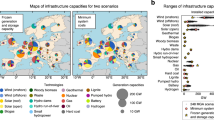Abstract
Impetus to expand electricity access in developing nations is urgent1. Yet aspirations to provide universal access to electricity are often considered potentially conflicting with efforts to mitigate climate change2. How much newly electrified, largely poor, households raise emissions, however, remains uncertain. Results from a first retrospective analysis show that improvements in household electricity access contributed 3–4% of national emissions growth in India over the past three decades. Emissions from both the direct and indirect electricity use of more than 650 million people connected since 1981 accounted for 11–25% of Indian emissions growth or, on average, a rise of 0.008–0.018 tons of CO2 per person per year between 1981 and 2011. Although this is a marginal share of global emissions, it does not detract from the importance for developing countries to start reducing the carbon intensities of their electricity generation to ensure sustainable development and avoid future carbon lock-in3,4. Significant ancillary benefits for air quality, health, energy security and efficiency may also make this attractive for reasons other than climate mitigation alone5,6.
This is a preview of subscription content, access via your institution
Access options
Subscribe to this journal
Receive 12 print issues and online access
$209.00 per year
only $17.42 per issue
Buy this article
- Purchase on Springer Link
- Instant access to full article PDF
Prices may be subject to local taxes which are calculated during checkout


Similar content being viewed by others
References
Secretary-General UN A Vision Statement by Ban Ki-moon Secretary-General of the United Nations — Sustainable Energy for all (United Nations, 2011).
Moss, T., Roger Pielke, J. & Bazilian, M. Balancing Energy Access and Environmental Goals in Development Finance: The Case of the OPIC Carbon Cap (Center for Global Development, 2014).
Rogelj, J. et al. Halfway to Copenhagen, no way to 2 °C. Nature Clim. Change 3, 81–83 (2009).
Bertram, C. et al. Carbon lock-in through capital stock inertia associated with weak near-term climate policies. Technol. Forecast. Soc. Change http://dx.doi.org/10.1016/j.techfore.2013.10.001 (2013).
Wilkinson, P. et al. Public health benefits of strategies to reduce greenhouse-gas emissions: Household energy. Lancet 374, 1917–1929 (2009).
IPCC in Climate Change 2014: Mitigation of Climate Change (eds Edenhofer, O. et al.) (Cambridge Univ. Press, 2014).
Khandker, S. R., Samad, H. A., Ali, R. & Barnes, D. F. Who benefits most from rural electrification? Evidence in India. Energy J. 35, 75–96 (2014).
Dinkelman, T. The effects of rural electrification on employment: New evidence from South Africa. Am. Econ. Rev. 101, 3078–3108 (2011).
Rao, N. D. Does (better) electricity supply increase household enterprise income in India? Energy Policy 57, 532–541 (2013).
Registrar General of India Data on Housing, Table H Series (Census of India, 2011).
Barnes, D. F. The Challenge of Rural Electrification: Strategies for Developing Countries (RFF Press, 2007).
Bhattacharyya, S. C. Energy access programmes and sustainable development: A critical review and analysis. Energy Sustain. Dev. 16, 260–271 (2012).
GEA Global Energy Assessment — Toward a Sustainable Future (Cambridge Univ. Press and the International Institute for Applied Systems Analysis, 2012).
Nilsson, M. et al. Energy for a Shared Development Agenda: Global Scenarios and Governance Implications (Stockholm Environment Institute, 2012).
Matthews, H. D. et al. National contributions to observed global warming. Environ. Res. Lett. 9, 014010 (2014).
Chakravarty, S. & Tavoni, M. Energy poverty alleviation and climate change mitigation: Is there a trade off? Energy Econ. 40, S67–S73 (2013).
Pachauri, S. et al. Pathways to achieve universal household access to modern energy by 2030. Environ. Res. Lett. 8, 024015 (2013).
IEA CO2 Emissions from Fuel Combustion Statistics (OECD and IEA, 2013).
NSSO Household Consumer Expenditure Surveys (National Sample Survey Organization, Ministry of Statistics and Program Implementation).
CEA All India Electricity Statistics General Review (Central Electricity Authority, Ministry of Power).
Shrestha, R. M., Anandarajah, G. & Liyanage, M. H. Factors affecting CO2 emission from the power sector of selected countries in Asia and the Pacific. Energy Policy 37, 2375–2384 (2009).
Pachauri, S. & Spreng, D. in Tackling Long-Term Energy Problems: The Contribution of Social Science (eds Spreng, D., Flueler, T., Goldblatt, D. L. & Minsch, J.) 73–96 Ch. 5, (Springer, 2012).
Pachauri, S. An Energy Analysis of Household Consumption: Changing Patterns of Direct and Indirect Use in India (Springer, 2007).
Grubler, A. & Pachauri, S. Problems with burden-sharing proposal among one billion high emitters. Proc. Natl Acad. Sci. USA 106, E122–123; author reply E124 (2009).
Chakravarty, S. & Ramana, M. V. in Handbook of Climate Change and India: Development, Politics and Governance (ed Dubash, N. K.) 218–229 (Oxford Univ. Press, 2011).
IEA World Energy Outlook 2011 (International Energy Agency (IEA) and the Organisation of Economic Co-operation and Development (OECD), 2011).
AGECC Energy for a Sustainable Future: Summary Report and Recommendations (The UN Secretary-General’s Advisory Group on Energy and Climate Change (AGECC), 2010).
Action, P. Poor Peoples Energy Outlook 2010 (Practical Action, 2010).
Narula, K., Nagai, Y. & Pachauri, S. The role of decentralized distributed generation in achieving universal rural electrification in South Asia by 2030. Energy Policy 47, 345–357 (2012).
Ang, B. W. Decomposition analysis for policymaking in energy. Energy Policy 32, 1131–1139 (2004).
Acknowledgements
This work uses data from the Ministry of Statistics and Programme Implementation of the Government of India, the Census of India, and India’s Central Electricity Authority. I thank my IIASA colleagues in the Energy (ENE) program for useful discussions and comments, and my colleagues in the Communications Department for help with the figures. I am also grateful to A. Grubler, K.R. Smith and D. Spreng for valuable feedback on initial drafts.
Author information
Authors and Affiliations
Corresponding author
Ethics declarations
Competing interests
The author declares no competing financial interests.
Supplementary information
Rights and permissions
About this article
Cite this article
Pachauri, S. Household electricity access a trivial contributor to CO2 emissions growth in India. Nature Clim Change 4, 1073–1076 (2014). https://doi.org/10.1038/nclimate2414
Received:
Accepted:
Published:
Issue Date:
DOI: https://doi.org/10.1038/nclimate2414
This article is cited by
-
Distributional impacts of carbon pricing in developing Asia
Nature Sustainability (2021)
-
How social scientists can help to shape climate policy
Nature (2017)
-
An index of inequality in China
Nature Energy (2017)



